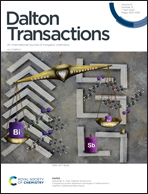What controls the magnetic anisotropy in heptacoordinate high-spin cobalt(ii) complexes? A theoretical perspective†
Abstract
The magnetic anisotropy of sixteen seven-coordinate high-spin CoII complexes with O, N, Cl and I donors was investigated with state-of-the-art ab initio CASSCF/NEVPT2 calculations and compared with experimental data. Based on the nature of the equatorial and axial ligands, which were found to tune the zero-field splitting, the complexes were classified into four groups. The experimental zero-field splitting parameters D which, for the various structures are in a range of +30 to +60 cm−1, as well as the g and E values are well reproduced. The investigation of the electronic structure shows that in these pentagonal bipyramidal complexes the donors and symmetry in the equatorial plane play an important role in the values of the axial zero-field splitting parameter D, and breaking of the horizontal plane of symmetry was found to enhance the magnitude of the D value. Although negative values of D are a desired condition for SIMs, many CoII based SIMs with positive zero-field splitting are fundamentally important to understand the nature of magnetic anisotropy, and seven coordinate CoII complexes with a large overall crystal field splitting might provide a way forward in this class of molecules.



 Please wait while we load your content...
Please wait while we load your content...